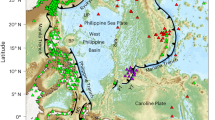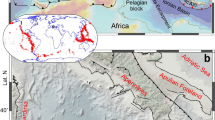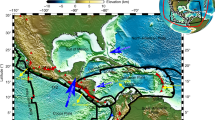Abstract
Seismic anisotropy provides key information to map the trajectories of mantle flow and understand the evolution of our planet. While the presence of anisotropy in the uppermost mantle is well established, the existence and nature of anisotropy in the transition zone and uppermost lower mantle are still debated. Here we use three-dimensional global seismic tomography images based on a large dataset that is sensitive to this region to show the ubiquitous presence of anisotropy in the lower mantle beneath subduction zones. Whereas above the 660 km seismic discontinuity slabs are associated with fast SV anomalies up to about 3%, in the lower mantle fast SH anomalies of about 2% persist near slabs down to about 1,000–1,200 km. These observations are consistent with 3D numerical models of deformation from subducting slabs and the associated lattice-preferred orientation of bridgmanite produced in the dislocation creep regime in areas subjected to high stresses. This study provides evidence that dislocation creep may be active in the Earth’s lower mantle, providing new constraints on the debated nature of deformation in this key, but inaccessible, component of the deep Earth.
This is a preview of subscription content, access via your institution
Access options
Access Nature and 54 other Nature Portfolio journals
Get Nature+, our best-value online-access subscription
$29.99 / 30 days
cancel any time
Subscribe to this journal
Receive 12 print issues and online access
$259.00 per year
only $21.58 per issue
Buy this article
- Purchase on Springer Link
- Instant access to full article PDF
Prices may be subject to local taxes which are calculated during checkout




Similar content being viewed by others
Code availability
The large scale subduction models were built using the code I3MG, which is not freely available and was kindly provided by T. Gerya.
The mantle fabric calculations used a modified version of the code D-REX available at http://www.ipgp.fr/~kaminski/web_doudoud/DRex.tar.gz.
Data availability
The data that support the findings of this study are available from the corresponding author on request. The tomography model SGLOBE-rani used in this study is available in the IRIS Data Services Products (http://ds.iris.edu/ds/products/emc-earthmodels/).
References
Spakman, W., van der Lee, S. & van der Hilst, R. D. Travel-time tomography of the European-Mediterranean mantle down to 1400 km. Phys. Earth Planet. Inter. 79, 3–74 (1993).
Van der Hilst, R. D., Widiyantoro, S. & Engdahl, E. R. Evidence for deep mantle circulation from global tomography. Nature 386, 578–584 (1997).
Fukao, Y. & Obayashi, M. Subducted slabs stagnant above, penetrating through, and trapped below the 660 km discontinuity. J. Geophys. Res. 118, 5920–5938 (2013).
French, S. W. & Romanowicz, B. Broad plumes rooted at the base of the earth’s mantle beneath major hotspots. Nature 525, 95–99 (2015).
Ballmer, M. D., Schmerr, N. C., Nakagawa, T. & Ritsema, J. Compositional mantle layering revealed by slab stagnation at ~1,000 km depth. Sci. Adv 1, e1500815 (2015).
King, S. D., Frost, D. J. & Rubie, D. C. Why cold slabs stagnate in the transition zone. Geology 43, 231–234 (2015).
Rudolph, M. L., Lekic, V. & Lithgow-Bertelloni, C. Viscosity jump in earth’s mid-mantle. Science 350, 1349 (2015).
Marquardt, H. & Miyagi, L. Slab stagnation in the shallow lower mantle linked to an increase in mantle viscosity. Nat. Geosci. 8, 311–314 (2015).
Miyagi, L. & Wenk, H.-R. Texture development and slip systems in bridgmanite and bridgmanite + ferropericlase aggregates. Phys. Chem. Miner. 43, 597–613 (2016).
Tsujino, N., Yamazaki, D., Seto, Y., Higo, Y. & Takahashi, E. Mantle dynamics inferred from the crystallographic preferred orientation of bridgmanite. Nature 539, 81–84 (2016).
Yamazaki, D. & Karato, S.-I. Fabric development in (Mg, Fe)O during large strain, shear deformation: Implications for seismic anisotropy in Earth’s lower mantle. Phys. Earth Planet. Inter. 131, 251–267 (2002).
Lay, T., Williams, Q., Garnero, E. J., Kellogg, L. & Wysession, M. E. in The Core-Mantle Boundary Region (eds Gurnis, M. et al.) Vol. 28 299–318 (American Geophysical Union, Washington DC,1998).
Beghein, C. & Trampert, J. Probability density functions for radial anisotropy: implications for the upper 1200 km of the mantle. Earth Planet. Sci. Lett. 217, 151–162 (2003).
Panning, M. & Romanowicz, B. A three-dimensional radially anisotropic model of shear velocity in the whole mantle. Geophys. J. Int. 167, 361–379 (2006).
Panning, M., Lekic, V. & Romanowicz, B. Importance of crustal corrections in the development of a new global model of radial anisotropy. J. Geophys. Res. 115, B12325 (2010).
Chang, S.-J., Ferreira, A. M. G., Ritsema, J., van Heijst, H. J. & Woodhouse, J. H. Global radially anisotropic mantle structure from multiple datasets: a review, current challenges, and outlook. Tectonophysics 617, 1–19 (2014).
Karato, S.-I., Zhang, S. & Wenk, H.-R. Superplasticity in earth’s lower mantle: evidence from seismic anisotropy and rock physics. Science 270, 458–461 (1995).
Boioli, F. et al. Pure climb creep mechanism drives flow in Earth’s lower mantle. Sci. Adv. 3, e160195 (2017).
Wookey, J. & Kendall, J.-M. Evidence of midmantle anisotropy from shear wave splitting and the influence of shear-coupled P wave. J. Geophys. Res. 109, B07309 (2004).
Walpole, J., Wookey, J., Kendall, J.-M. & Masters, T. G. Seismic anisotropy and mantle flow below subducting slabs. Earth Planet. Sci. Lett. 465, 155–167 (2017).
Nowacki, A., Kendall, J. M., Wookey, J. & Pemberton, A. Mid-mantle anisotropy in subduction zones and deep water transport. Geochem. Geophys. Geosys. 16, 764–784 (2015).
Montagner, J.-P. Can seismology tell us anything about convection in the mantle? Rev. Geophys. 32, 115–137 (1994).
Chang, S.-J., Ferreira, A. M. G. & Faccenda, M. Upper- and mid-mantle interaction between the samoan plume and the Tonga-Kermadec slabs. Nat. Commun. 7, 10799 (2016).
Marone, F. & Romanowicz, B. Non-linear crustal corrections in high-resolution waveform seismic tomography. Geophys. J. Int. 170, 460–467 (2007).
Bozdag, E. & Trampert, J. On crustal corrections in surface wave tomography. Geophys. J. Int. 172, 1076–1088 (2007).
Ferreira, A. M. G., Woodhouse, J. H., Visser, K. & Trampert, J. On the robustness of global radially anisotropic surface wave tomography. J. Geophys. Res. 115, B04313 (2010).
Chang, S.-J. & Ferreira, A. M. G. Improving global radial anisotropy tomography: the importance of simultaneously inverting for crustal and mantle structure. Bull. Seismol. Soc. Am. 107, 624–638 (2017).
Chang, S.-J., Ferreira, A. M. G., Ritsema, J., van Heijst, H. J. & Woodhouse, J. H. Joint inversion for global isotropic and radially anisotropic mantle structure including crustal thickness perturbations. J. Geophys. Res. 120, 4278–4300 (2015).
Kustowski, B., Ekström, G. & Dziewonski, A. M. Anisotropic shear-wave velocity structure of the earth’s mantle: a global model. J. Geophys. Res. 113, B06306 (2008).
Moulik, P. & Ekström, G. An anisotropic shear velocity model of the earth’s mantle using normal modes, body waves, surface waves and long-period waveforms. J. Geophys. Res. 199, 1713–1738 (2014).
Auer, L., Boschi, L., Becker, T. W., Nissen-Meyer, T. & Giardini, D. Savani: a variable resolution whole-mantle model of anisotropic shear velocity variations based on multiple data sets. J. Geophys. Res. 119, 3006–3034 (2014).
MacQueen, J. In Proc. Fifth Berkeley Symp. Math. Stat. Prob. 281–297 (University of California Press, 1967); https://projecteuclid.org/euclid.bsmsp/1200512992
Houser, C., Masters, G., Shearer, P. & Laske, G. Shear and compressional velocity models of the mantle from cluster analysis of long-period waveforms. Geophys. J. Int. 174, 195–212 (2008).
Lekic, V. & Romanowicz, B. Tectonic regionalization without a priori information: a cluster analysis of upper mantle tomography. Earth Planet. Sci. Lett. 308, 151–160 (2011).
Faccenda, M. Mid mantle seismic anisotropy around subduction zones. Phys. Earth Planet. Inter. 227, 1–19 (2014).
Christensen, U. R. The influence of trench migration on slab penetration into the lower mantle. Earth Planet. Sci. Lett. 140, 27–39 (1996).
Faccenda, M. & Dal Zilio, L. The role of solid-solid phase transitions in mantle convection. Lithos 268–271, 198–224 (2017).
Ballmer, M. D., Houser, C., Hernlund, J. W., Wentzcovich, R. & Hirose, K. Persistence of strong silica-enriched domains in the Earth’s Lower mantle. Nat. Geosci. 10, 236–240 (2017).
McNamara, A. K., van Keken, P. E. & Karato, S.-I. Development of anisotropic structure in the earth’s lower mantle by solid-state convection. Nature 416, 310–314 (2002).
Wenk, H. R., Speziale, S., McNamara, A. K. & Garnero, E. J. Modeling lower mantle anisotropy development in a subducting slab. Earth Planet. Sci. Lett. 245, 302–314 (2006).
Mainprice, D. in Treatise on Geophysics Vol. 2 (ed. Schubert, G.) 437–492 (Elsevier, 2007).
Girard, J., Amulele, G., Farla, R., Mohiuddin, A. & Karato, S.-I. Shear deformation of bridgmanite and magnesiowüstite aggregates at lower mantle conditions. Science 351, 144–147 (2016).
Faccenda, M. et al. Extrinsic elastic anisotropy in a compositionally heterogeneous Earth’s mantle. J. Geophys. Res. https://doi.org/10.1029/2018JB016482 (2019).
Dziewoński, A. M. & Anderson, D. L. Preliminary reference earth model. Phys. Earth Planet. Inter. 25, 297–356 (1981).
Engdahl, E. R., Van der Hilst, R. D. & Buland, R. Global teleseismic earthquake relocation with improved travel times and procedures for depth determination. Bull. Seismol. Soc. Am. 88, 722–743 (1998).
Takeuchi, H. & Saito, M. in Methods of Computational Physics Vol. 11 (ed. Bolt, B. A.) 217–295 (Academic Press, New York, 1972).
Backus, G. E. & Gilbert, J. F. The resolving power of gross earth data. Geophys. J. R. Astron. Soc. 16, 169–205 (1968).
Bevington, P. R. & Robinson, D. K. Data Reduction and Error Analysis for the Physical Sciences 3rd edn (McGraw-Hill, 2002).
Forsyth, D. The early structural evolution and anisotropy of the oceanic upper mantle. Geophys. J. R. Astron. Soc. 43, 103–162 (1975).
Gerya, T. V. Introduction to Numerical Geodynamic Modelling (Cambridge Univ. Press, 2009).
Connolly, J. A. D. Computation of phase equilibria by linear programming: a tool for geodynamic modelling and its application to subduction zone decarbonation. Earth Planet. Sci. Lett. 236, 524–541 (2005).
McNamara, A. K., Karato, S.-H. & van Keken, P. Localization of dislocation creep in the lower mantle: implications for the origin of seismic anisotropy. Earth Planet. Sci. Lett. 191, 85–99 (2001).
Nakagawa, T., Tackley, P. J., Deschamps, F. & Connolly, J. A. D. Incorporating self-consistently calculated mineral physics into thermochemical mantle convection simulations in a 3-D spherical shell and its influence on seismic anomalies in earth’s mantle. Geochem. Geophys. Geosys. 10, Q03004 (2009).
Faccenda, M. & Capitanio, F. A. Seismic anisotropy around subduction zones: Insights from three-dimensional modelling of upper mantle deformation and sks splitting calculations. Geochem. Geophys. Geosyst. 14, 243–262 (2013).
Faccenda, M. & Capitanio, F. A. Development of mantle seismic anisotropy during subduction-induced 3-D flow. Geophys. Res. Lett. 39, L11305 (2012).
Tommasi, A., Mainprice, D., Cordier, P., Thoroval, C. & Couvy, H. Strain-induced seismic anisotropy of wadsleyite polycrystals and flow patterns in the mantle transition zone. J. Geophys. Res. 109, B12405 (2004).
Wentzcovitch, R. M., Karki, B. B., Cococcioni, M. & de Gironcoli, S. Thermoelastic Properties of MgSiO3-perovskite: insights on the nature of the earth’s lower mantle. Phys. Rev. Lett. 92, 018501 (2004).
Zhang, Z., Stixrude, L. & Brodholt, J. Elastic properties of MgSiO3-perovskite under lower mantle conditions and the composition of the deep earth. Earth Planet. Sci. Lett. 379, 1–12 (2013).
Backus, G. E. Long-wave elastic anisotropy produced by horizontal layering. J. Geophys. Res. 67, 4427–4440 (1962).
Stixrude, L. & Lithgow-Bertelloni, C. Thermodynamics of mantle minerals II. phase equilibria. Geophys. J. Int. 184, 1180–1213 (2011).
Acknowledgements
This research was initially supported by the Leverhulme Trust (project no. F/00 204/AS), followed by support from NERC project NE/K005669/1 and the Korea Meteorological Administration Research and Development Program under grant no. KMI2018-09312. A.M.G.F. also acknowledges discussions supported by COST Action ES1401-TIDES. M.F. was supported by the Progetto di Ateneo FACCPTRAT12 granted by the Università di Padova and by the ERC StG #758199 NEWTON. We acknowledge the availability of global seismograms from the IRIS Data Services and the II, IU, GEOSCOPE and GEOFON networks. The inversions were carried out initially on the High Performance Computing Cluster supported by the Research and Specialist Computing Support services at the University of East Anglia followed by the national UK supercomputing facilities HECToR and Archer. Geodynamic simulations were performed on the Galileo Computing Cluster, CINECA, Italy, thanks to the computational time assigned to M.F. under the NUMACOP and NUMACOP2 projects. We thank J. Brodholt for fruitful discussions and for his valuable suggestions. We also thank our colleagues D. Dobson and A. Song for fruitful discussions, and we are grateful to C. Lithgow-Bertelloni and L. Stixrude for providing HeFESTo’s results. We are grateful to Z. Zhang for providing bridgmanite’s full elastic constants from ab-initio calculations.
Author information
Authors and Affiliations
Contributions
A.M.G.F. designed the study, performed analyses of the tomography images, interpreted the results and wrote the first draft of the manuscript. M.F. contributed to the design of the study, performed and analysed geodynamic models, mantle fabric and SPO calculations, and wrote the text on the geodynamics part of the study. W.S. performed geodynamic models and mantle fabric calculations and prepared some of the tomography and geodynamics figures. S.-J.C. performed analyses of the tomography images and statistical tests of the seismic images. L.S. assisted the analyses of the tomography images and composing the figures.
Corresponding author
Ethics declarations
Competing interests
The authors declare no competing interests.
Additional information
Publisher’s note: Springer Nature remains neutral with regard to jurisdictional claims in published maps and institutional affiliations.
Supplementary information
Supplementary Information
Supplementary Figures and Tables
Supplementary Video 1
Simulation of slab stagnation at the 660-km discontinuity.
Supplementary Video 2
Simulation of slab penetration to the lower mantle.
Rights and permissions
About this article
Cite this article
Ferreira, A.M.G., Faccenda, M., Sturgeon, W. et al. Ubiquitous lower-mantle anisotropy beneath subduction zones. Nat. Geosci. 12, 301–306 (2019). https://doi.org/10.1038/s41561-019-0325-7
Received:
Accepted:
Published:
Issue Date:
DOI: https://doi.org/10.1038/s41561-019-0325-7
This article is cited by
-
Remnants of shifting early Cenozoic Pacific lower mantle flow imaged beneath the Philippine Sea Plate
Nature Geoscience (2024)
-
Small-Scale Heterogeneity and Seismic Anisotropy in the Mid-Mantle: Oceanic Crust versus Meta-Stable Olivine
Journal of Earth Science (2022)
-
Large-scale variation in seismic anisotropy in the crust and upper mantle beneath Anatolia, Turkey
Communications Earth & Environment (2021)
-
Seismic evidence for subduction-induced mantle flows underneath Middle America
Nature Communications (2020)



